Tạp chí Khoa học & Công nghệ Thủy sản - Số 2/2019
TÓM TẮT Một trong những giải pháp hiệu quả để ngăn ngừa hiện tượng suy thoái mạng lưới gel dẫn đến làm suy giảm chất lượng của cảm quan và tính chất lưu biến của surimi là bổ sung tinh bột được biến tính bằng các tác nhân gây biến tính như vật lý, enzyme hoặc tác nhân hóa học để làm thay đổi tính chất vật lý cũng như hóa học của tinh bột. Mục tiêu của nghiên cứu này là đánh giá ảnh hưởng của chế độ thủy phân bằng HCl đến chất lượng của tinh bột bắp biến tính (Maltodextrin). Kết quả nghiên cứu cho thấy điều kiện thủy phân tinh bột bắp thích hợp là tỷ lệ tinh bột/dd acid 10,4g/mL, dung dịch acid HCl nồng độ 8,92%, thời gian thủy phân 9 ngày, sản phẩm được ứng dụng sản xuất surimi cá Hố đạt loại tốt theo TCVN 8682:2011. Từ khóa: tinh bột bắp, tinh bột biến tính, maltodextrin, surimi cá Hố ABSTRACT Using modifi ed starch is one of the effective approaches for preventing gel degeneration leading to changes in sensory quality and rheological properties of surimi. Starch is hydrolyzed into maltodextrin by physical, enzymatic or chemical methods. The objective of this study was to evaluate the effects of hydrolysis condition on the quality of modifi ed corn starch (maltodextrin). The results showed that the appropriate hydrolysis conditions were 10.4g/mL corn starch, 8.92% HCl acid and 9 days. The quality of hairtail surimi produced using maltodextrin was ranked the good grade based on Vietnam standard for frozen surimi (TCVN 8682:2011)
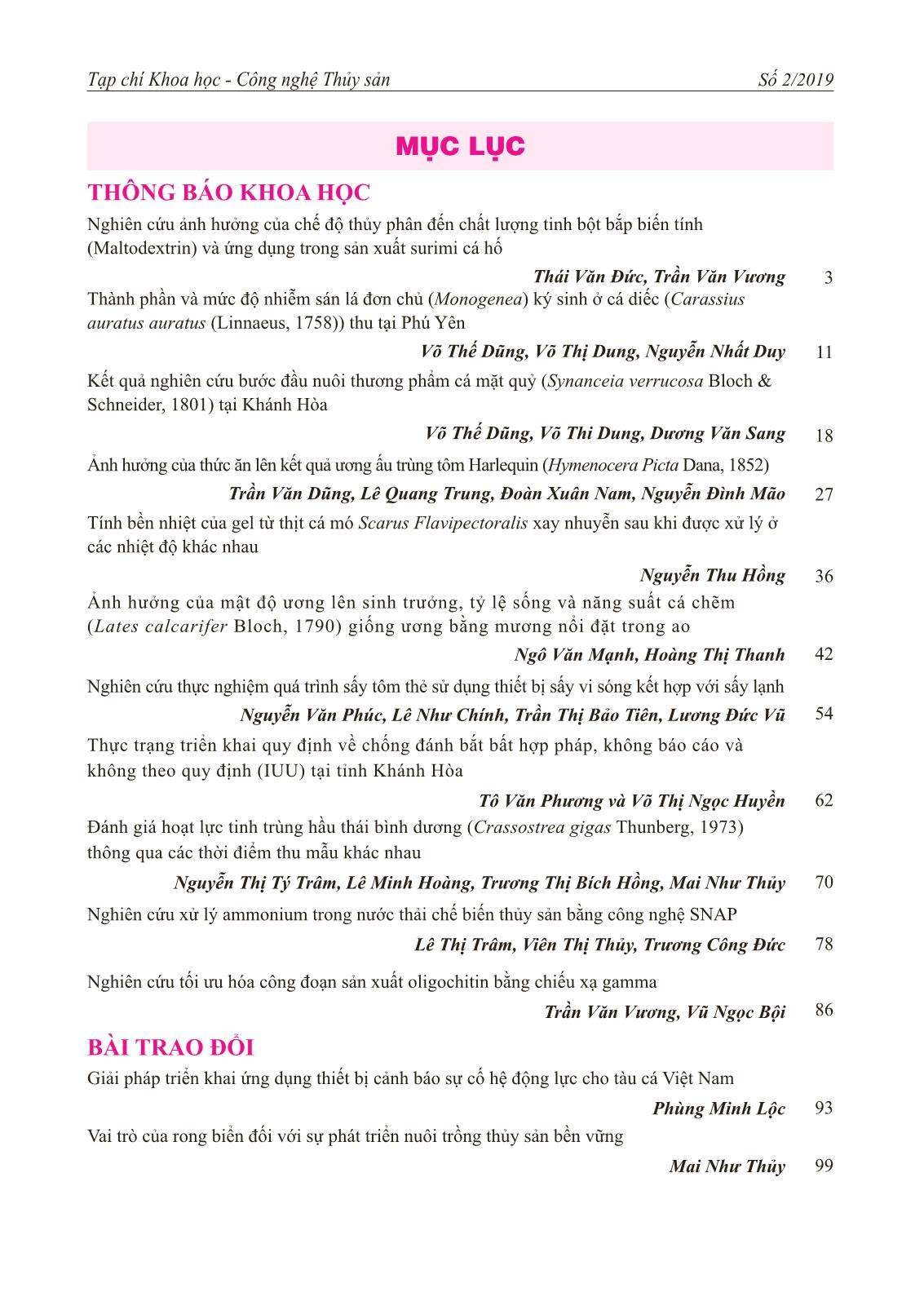
Trang 1
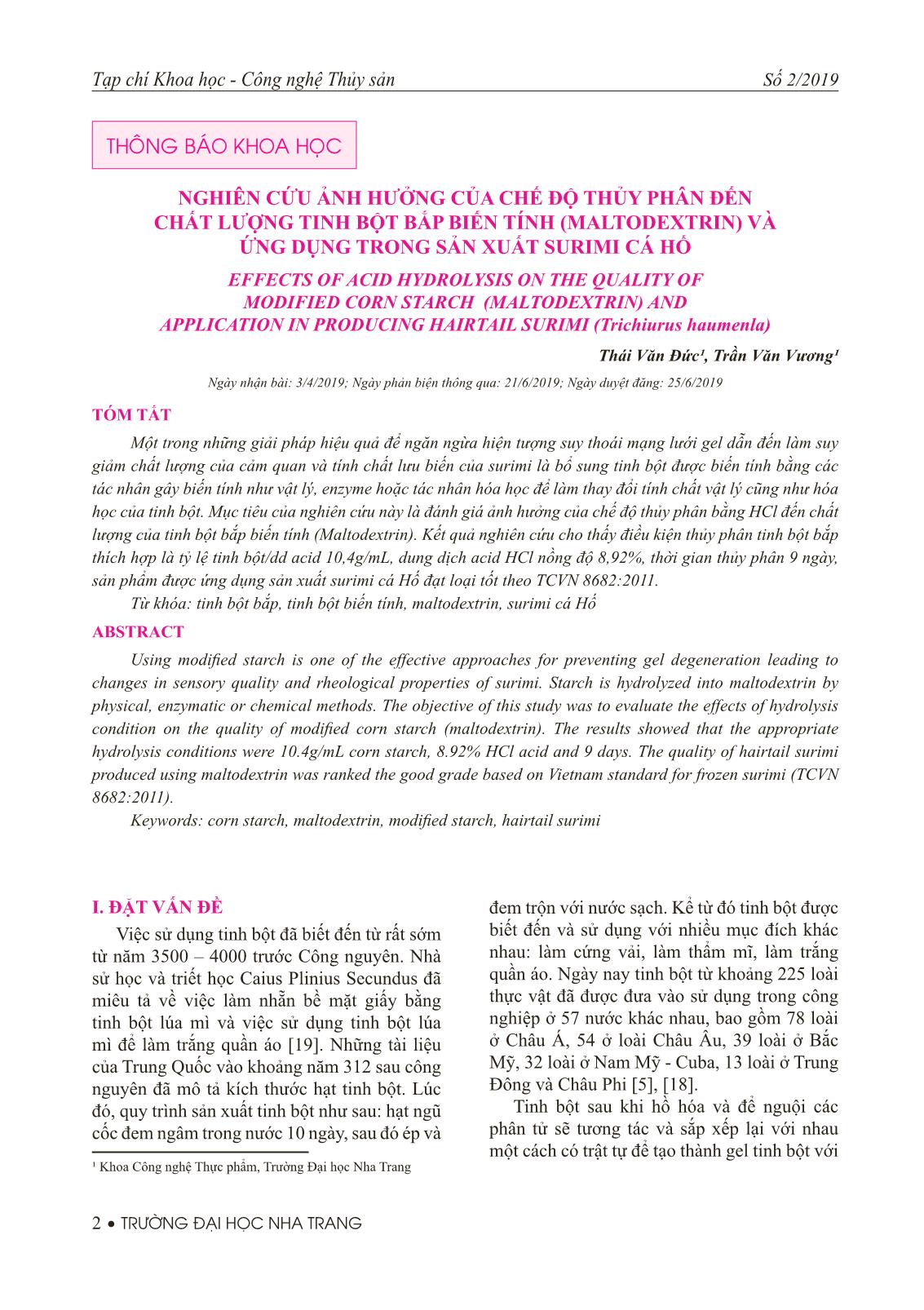
Trang 2
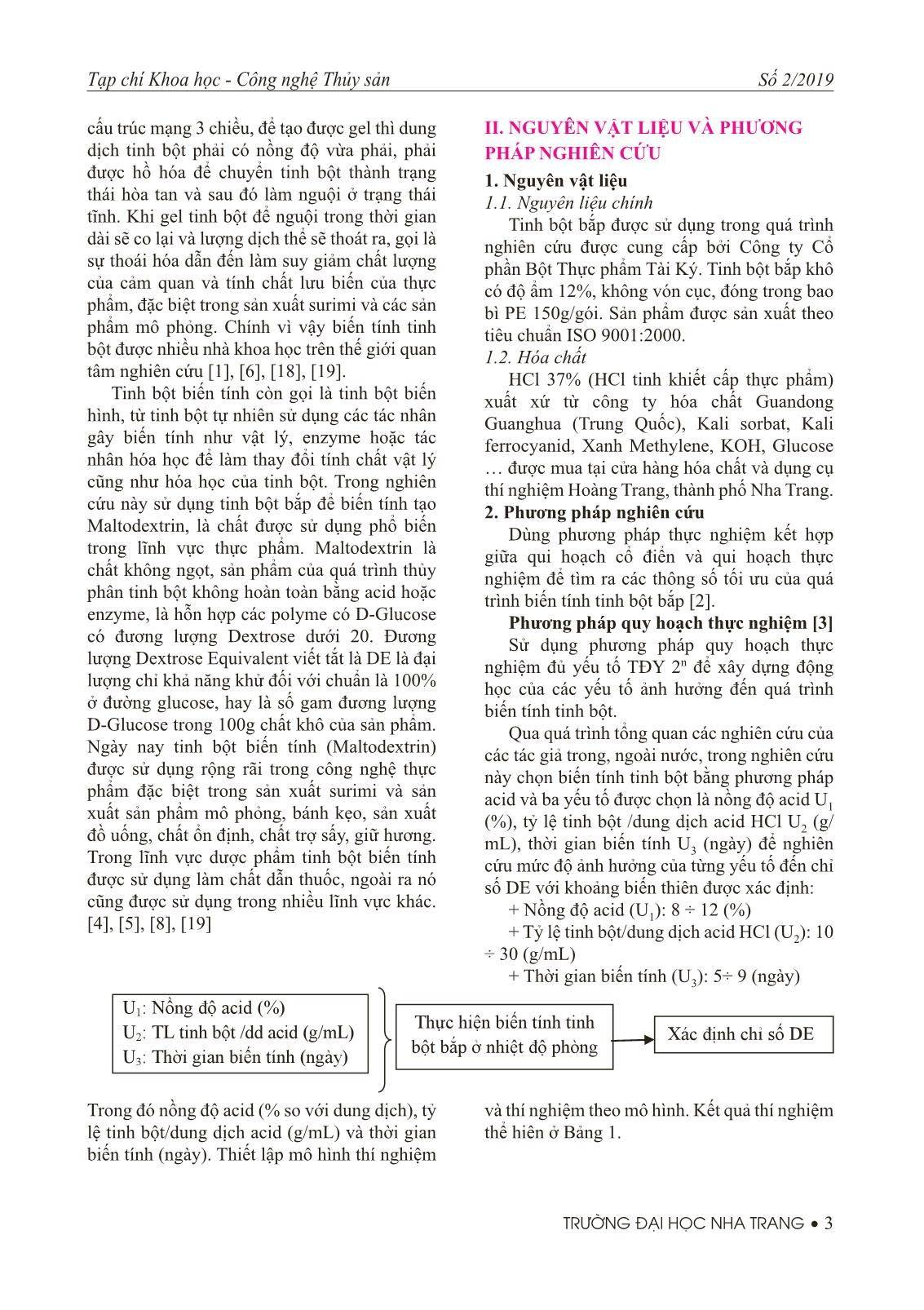
Trang 3

Trang 4
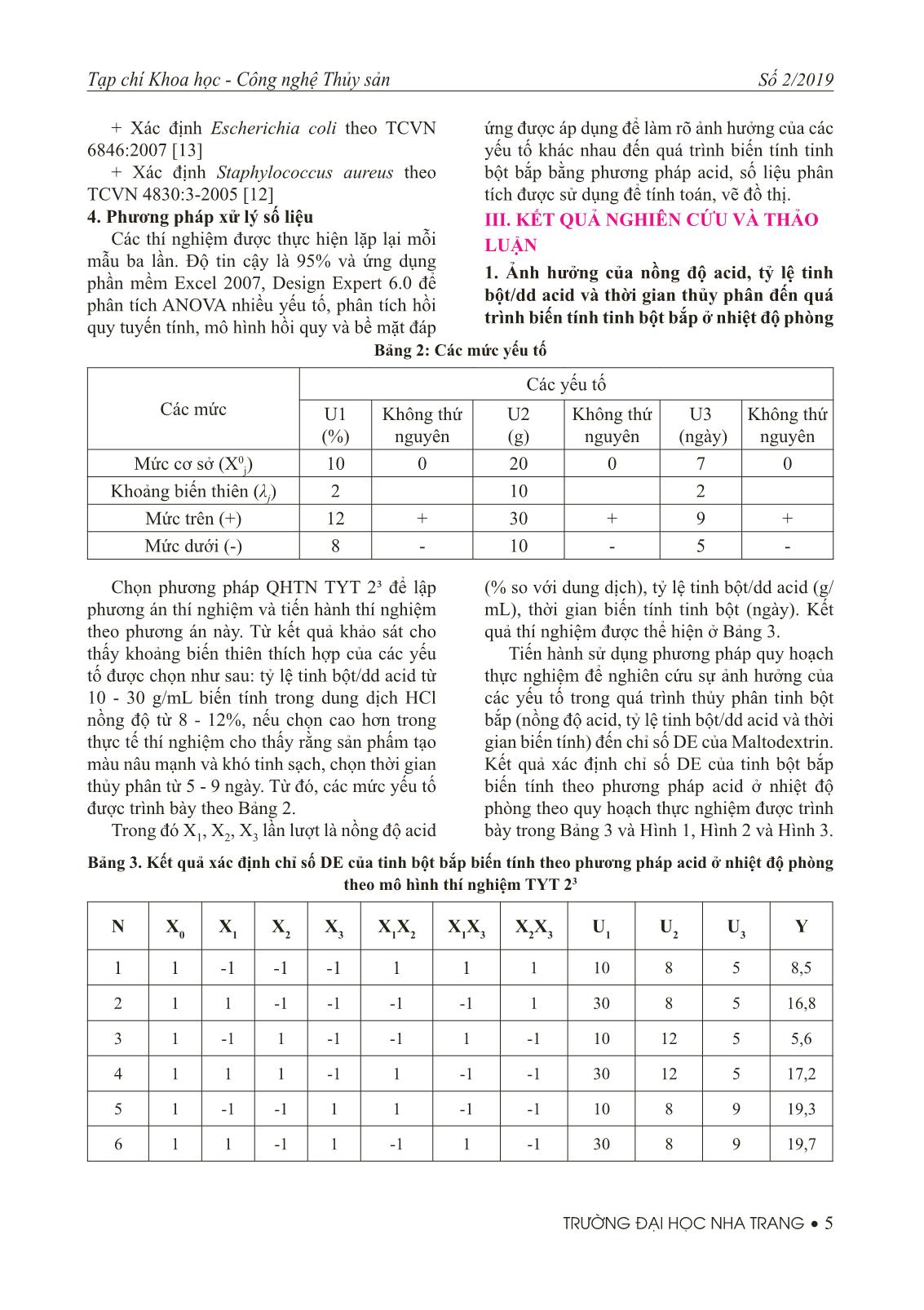
Trang 5
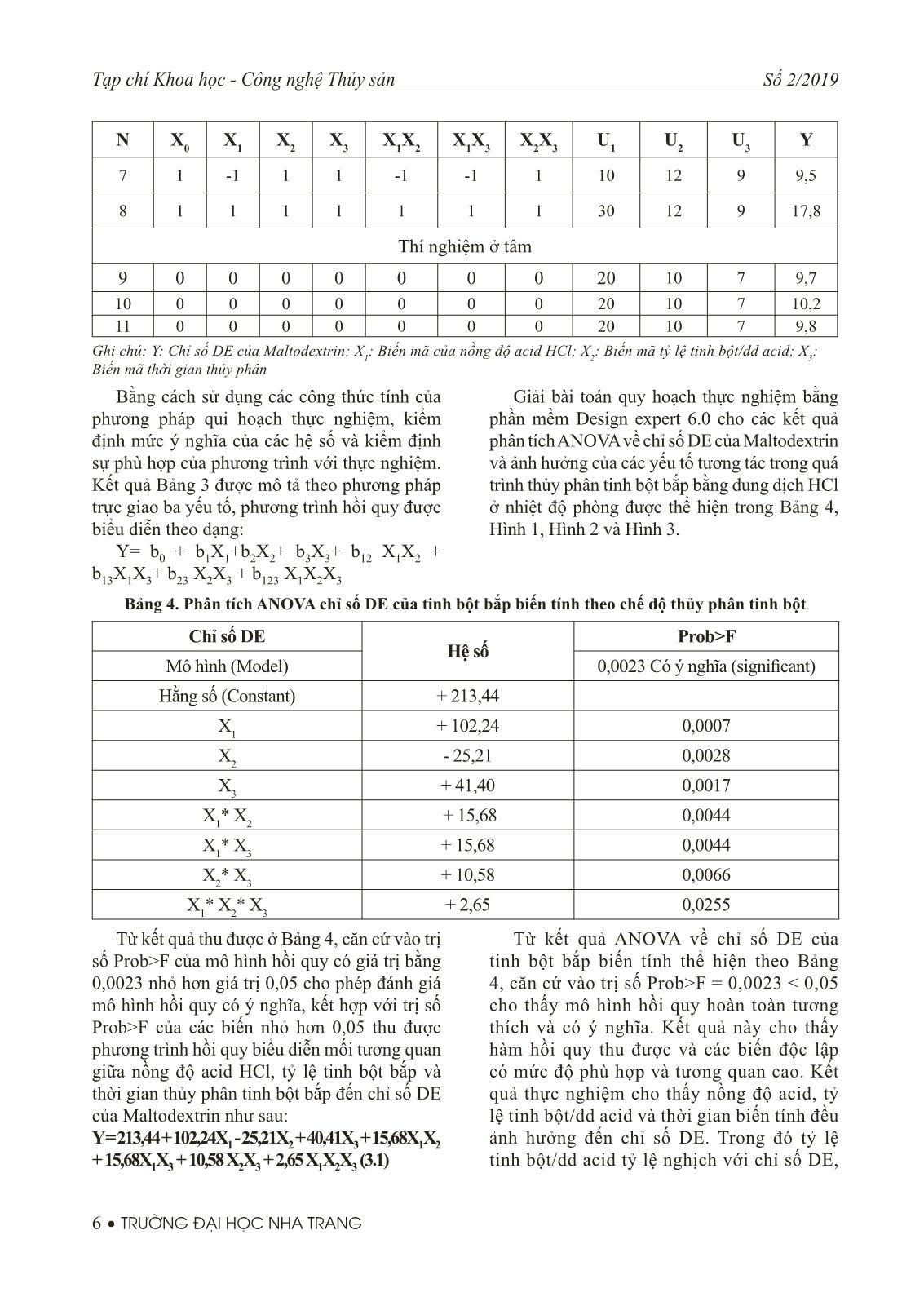
Trang 6
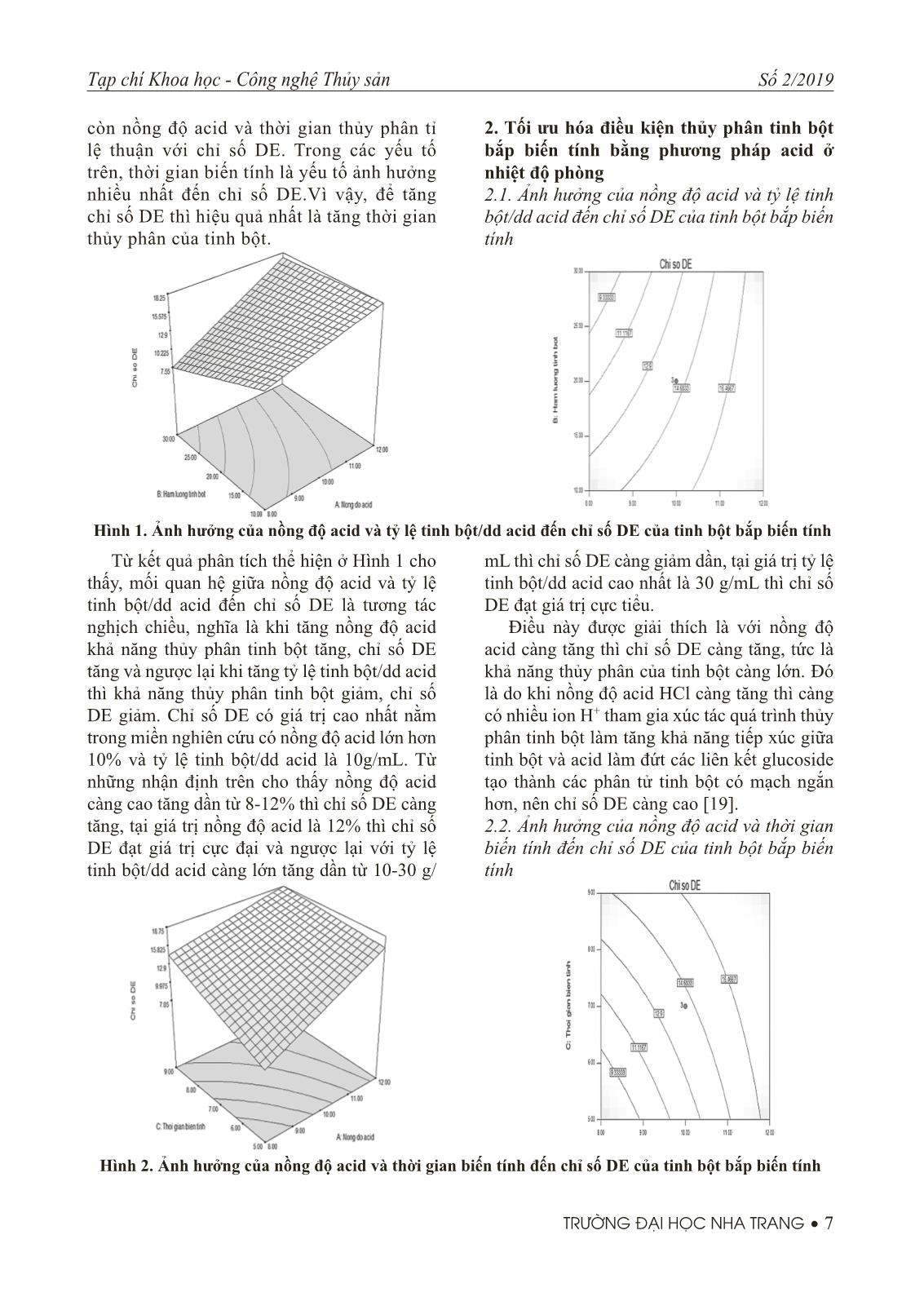
Trang 7
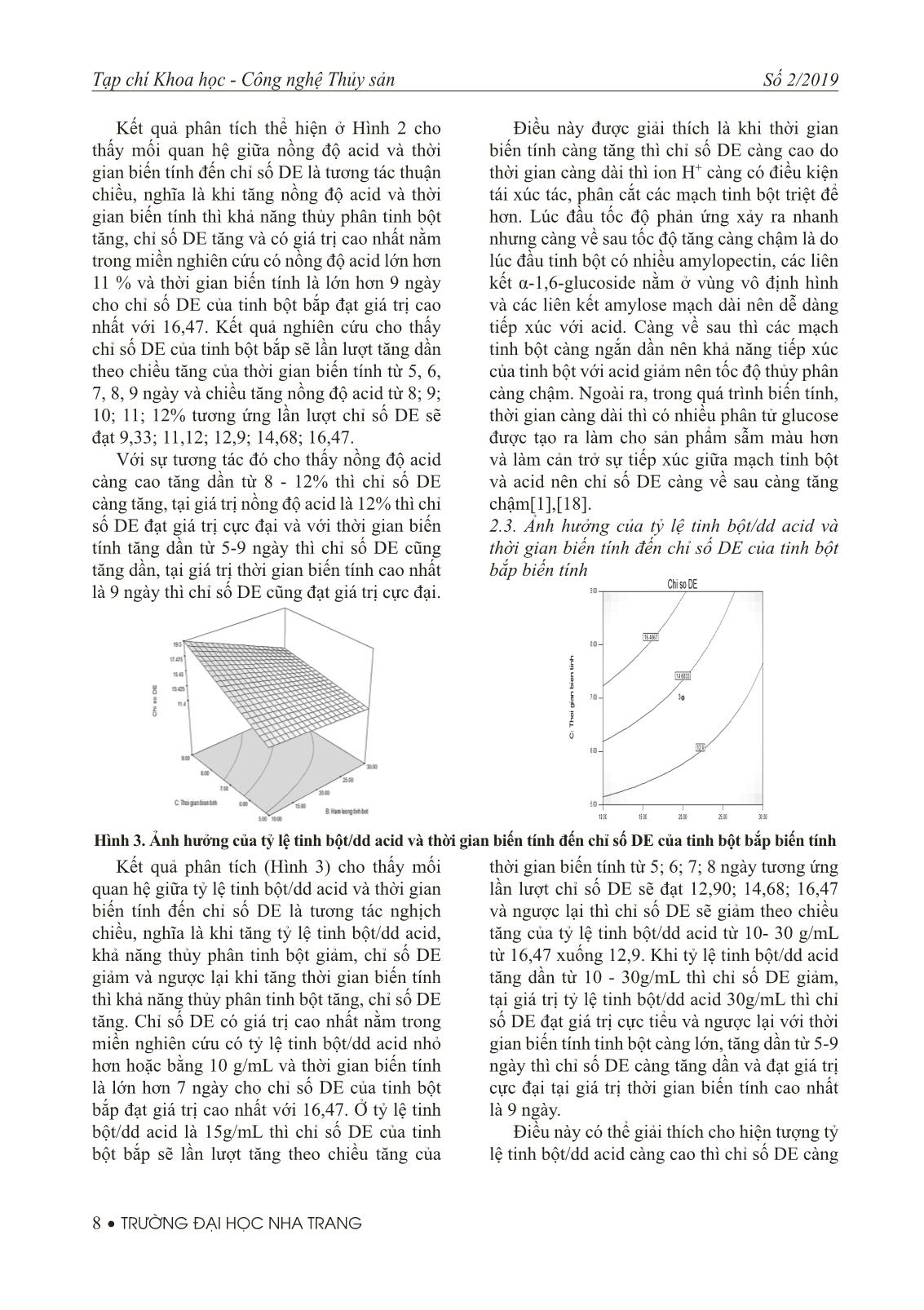
Trang 8
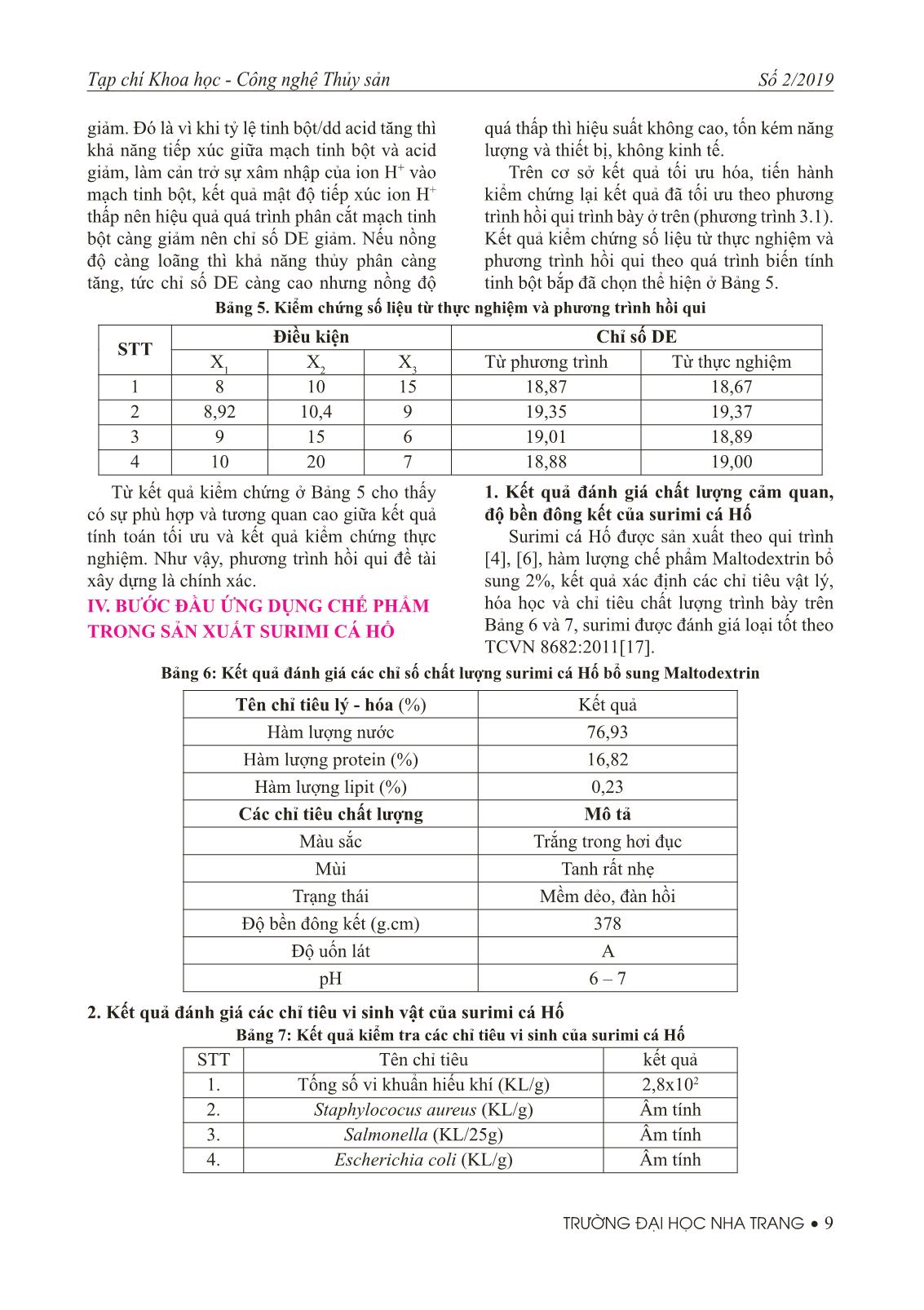
Trang 9
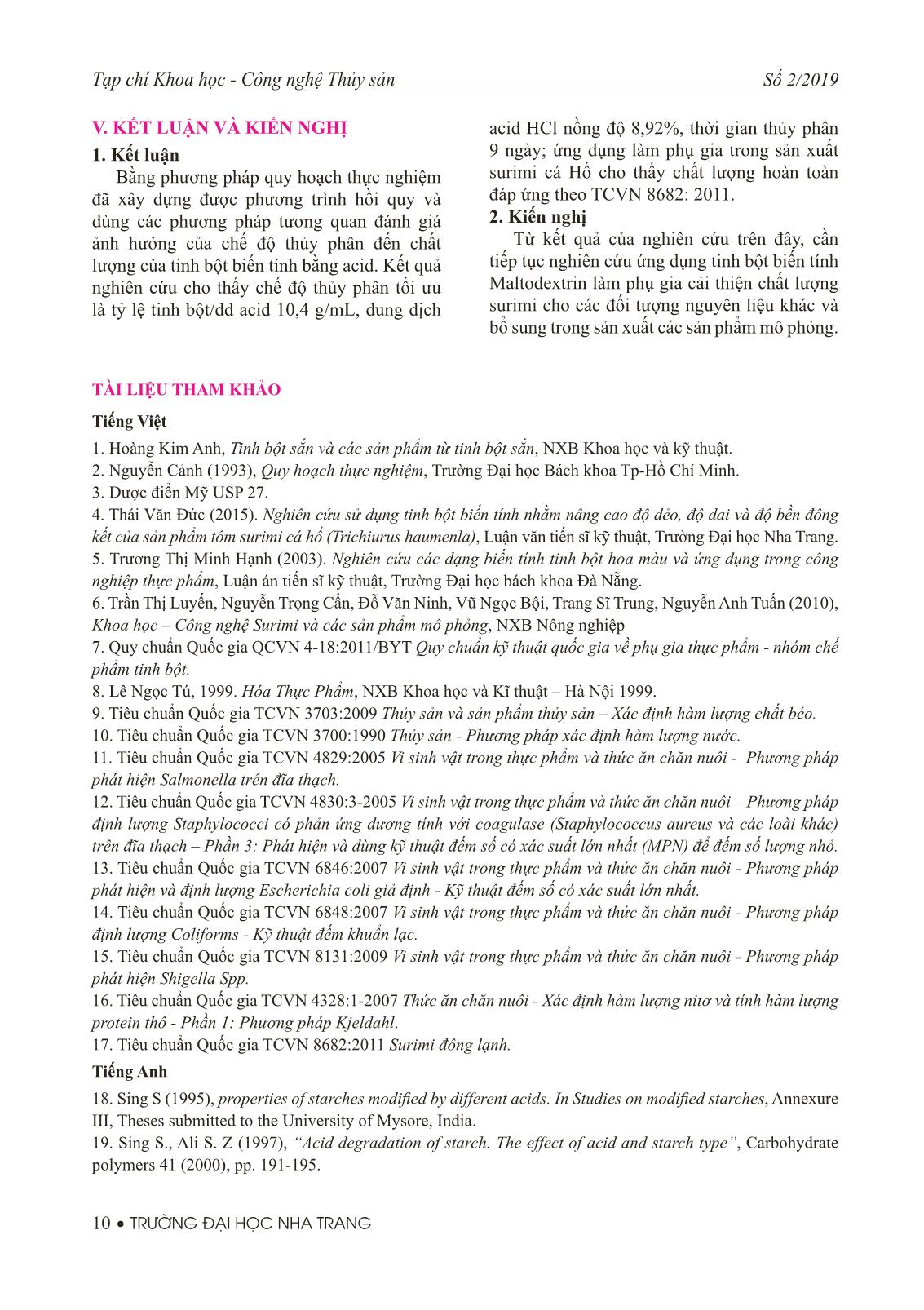
Trang 10
Tải về để xem bản đầy đủ
Tóm tắt nội dung tài liệu: Tạp chí Khoa học & Công nghệ Thủy sản - Số 2/2019
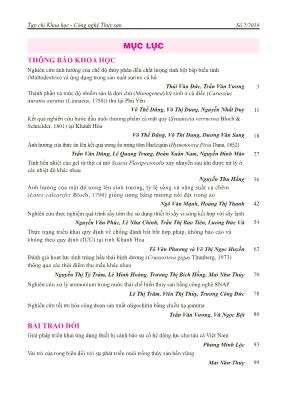
urnal of Phycology, 52:4, 391- 406. 2. Bjerregaard Rasmus, Valderrama Diego, Radulovich Ricardo, Diana James, Capron Mark, Mckinnie Cedric Amir, Cedric Michael, Hopkins Kevin, Yarish Charles, Goudey Clifford, Forster John, 2016. Seaweed aquaculture for food security, income generation and environmental health in Tropical Developing Countries (English). Washington, D. C.: World Bank Group. 3. Brijesh K. Tiwari, Declan J. Troy, 2015. Seaweed Sustainability: Food and Non-Food Applications. Academic Press: 488. 4. Cruz-Suárez L.E., Tapia Salazar M., Nieto López M. G. y D. Ricque, 2008. A review of the effects of macroalgae in shrimp feeds and in co-culture. Avances en Nutrición Acuícola IX, 304-333. 5. Dy Peñafl orida, V., & Golez, N. V., 1996. Use of seaweed meals from Kappaphycus alvarezii and Gracilaria heteroclada as binders in diets for juvenile shrimp Penaeus monodon. Aquaculture, 143(3-4), 393-401. 6. FAO, 2018. The global status of seaweedproduction, trade and utilization. Globe fi sh Research Programme, 124. Rome. 7. FAO, 2018. The State of World Fisheries and Aquaculture, 227. Rome. 8. Flower E. Msuya and Amir Neori, 2002. Ulva reticulata and Gracilaria crassa: Macroalgae That Can Biofi lter Effl uent from Tidal Fishponds in Tanzania. J. Mar. Sci., 117 – 126. 9. Habte-Tsion HM, 2017. Sustainable aquaculture development and its role in food security and economic growth in eritrea: Trends and Prospects. Ann Aquac Res, 4 (1): 1029. 10. K. Suresh Kumar, K. Ganesan, and P. V. Subba Rao, 2015. Seasonal variation in nutritional composition of Kappaphycus alvarezii (Doty) Doty - an edible seaweed. Journal of Food Sci Technol, 52(5): 2751–2760. 11. Leonel Pereira, 2011. A review of the nutrient composition of selected edible seaweed. In: Seaweed: Ecology, Nutrient Composition and Medicinal Uses. Nova Science Publishers, Inc., 15 – 47. 12. N. N. Ilias, P. Jamal, I. Jaswir, S. Sulaiman, Z. Zainudin, A. S. Azmt, 2015. Potentiality of selected seaweed 108 • TRƯỜNG ĐẠI HỌC NHA TRANG Tạp chí Khoa học - Công nghệ Thủy sản Số 2/2019 for the production of nutritious fi sh feed using solid state fermentation. Journal of Engineering Science and Technology, Special Issue on SOMCHE 2014 & RSCE 2014 Conference, 30 – 40. 13. Phillips, M., 1990. Environmental aspects of seaweed culture. In Regional workshop on the culture and utilization of seaweeds, Cebu City, Philippines, 27–31 August 1990. 14. Rama N., Elezabeth M., Uthayasiva M., Arularasan S., 2014. Seaweed Ulva reticulata a potential feed supplement for growth, colouration and disease resistance in fresh water ornamental gold fi sh, Carassius auratus. Journal of Aquaculture Research and Development, 5, 254-264. 15. Rajarajasri Pramila Devi and V. S. Gowri, 2007. Biological treatment of aquaculture discharge waters by seaweeds. Journal of Industrial pollution control, 23:1, 135 – 140. 16. Elizondo-González R, Quiroz-Guzmán E, Escobedo-Fregoso C, Magallón-Servín P, Peña-Rodríguez A., 2018. Use of seaweed Ulva lactuca for water bioremediation and as feed additive for white shrimp Litopenaeus vannamei. PeerJ 6: e4459; DOI 10.7717/peerj.4459. 17. Robson Liberal da Silva, José Milton Barbosa, 2009. Seaweed meal as a protein source for the white shrimp Litopenaeus vannamei. Journal of Applied Phycology, 21: 2, 193-197 18. Sasi Nayar and Kriston Bott, 2014. Current status of global cultivated seaweed production and markets World Aquaculture. 19. Nithiya Arumugam, Shreeshivadasan Chelliapan, Hesam Kamyab, Sathiabama Thirugnana, Norazli Othman and Noor Shawal Nasri, 2018. Treatment of Wastewater Using Seaweed: A Review Nithya Arumugam. Int. J. Environ. Res. Public Health, 15, 2851. 20. Vatsos, I.N. and Rebours, C., 2014. Seaweed extracts as antimicrobial agents in aquaculture. Journal of Applied Phycology, 27(5), 2017-2035. 21. Wei Wang, Shi-Xin Wang, and Hua-Shi Guan., 2012. The Antiviral Activities and Mechanisms of Marine Polysaccharides: An Overview. Mar Drugs, 10: 12, 2795–2816. 22. Yu-Hung Lin, Yi-Che Su, and Winton Cheng, 2017. Simple heat processing of brown seaweed Sargassum cristaefolium supplementation in diet can improve growth, immune responses and survival to vibrio alginolyticus of white shrimp, Litopenaeus vannamei. Journal of Marine Science and Technology, 25: 2,242-248. 23. Yun Hee Kang, Sang Rul Park and Ik Kyo Chung, 2011. Biofi ltration effi ciency and biochemical composition of three seaweed species cultivated in a fi sh-seaweed integrated culture. Algae, 26: 1, 97-108. 24. rong-bien-cho-hieu-qua-cao.html/ 25. https://www.aquaculturealliance.org/blog/seaweed-aquaculture-benefi ts/ 26. Aquaculture-Web.pdf 27. https://thriveglobal.com/stories/the-importance-of-sustainability-and-aquaculture/ 28. Tạp chí Khoa học - Công nghệ Thủy sản Số 2/2019 TRƯỜNG ĐẠI HỌC NHA TRANG • 109 I. HÌNH THỨC - Bài báo được trình bày trên giấy A4 theo chiều đứng (portrait), dài không quá 7 trang kể cả bảng, biểu và tài liệu tham khảo. - Canh lề: Top: 2 cm; Bottom: 2 cm; Left: 2 cm; Right: 2 cm; Header: 2 cm; Footer: 2 cm; - Bảng mã: Unicode; kiểu chữ: Times New Roman; Cỡ chữ: 11, Giãn dòng: single. - Mật độ chữ bình thường, không được nén hoặc kéo dãn khoảng cách giữa các chữ. - Chi tiết định dạng các mục như sau: THỂ LỆ VIẾT BÀI GỬI ĐĂNG TRÊN TẠP CHÍ KHOA HỌC - CÔNG NGHỆ THUỶ SẢN (*): Đối với những bài báo có nhiều tác giả, tên tác giả liệt kê đầu tiên được hiểu là tác giả chính. (**):Nhằm đảm bảo tính khoa học và rõ ràng cho bài viết, sau tiêu đề lớn nhất là các số la mã, các tiêu đề nhỏ trong từng phần thống nhất cách đánh là số thứ tự: 1, 2, 3...và chia nhỏ với các tiêu đề nhỏ hơn. II. CẤU TRÚC BÀI BÁO 1. Bài báo thuộc thể loại nghiên cứu 1.1. Tóm tắt bằng Tiếng Việt: Không quá 250 từ, tóm tắt những điểm quan trọng nhất của bài viết. Tuy phần tóm tắt ngắn nhưng phải chứa đựng đầy đủ nội dung, gồm các phần như mục tiêu và phạm vi nghiên cứu, miêu tả những phương pháp đã được sử dụng và kết quả nghiên cứu. Tất cả những gì được nêu trong tóm tắt đều phải hiện diện trong thân bài chính. 1.2. Tóm tắt bằng Tiếng Anh: Dịch từ tóm tắt bằng tiếng Việt. 1.3. Từ khoá: Liệt kê 3¸5 từ. 1.4. Đặt vấn đề: Tác giả có thể mở đầu bài báo bằng nhiều cách, nhưng phải nêu được những ý chính sau: tính cấp thiết, ý nghĩa, tác dụng của công trình nghiên cứu. Phần đặt vấn đề cần trình bày một cách ngắn gọn hiện trạng của những kiến thức có liên quan đến tồn tại hiện còn của vấn đề được giới thiệu trong bài gởi đăng và những cách xem xét về tồn tại đó. 110 • TRƯỜNG ĐẠI HỌC NHA TRANG Tạp chí Khoa học - Công nghệ Thủy sản Số 2/2019 1.5. Đối tượng, vật liệu và phương pháp nghiên cứu: Trình bày rõ đối tượng, vật liệu và phương pháp nghiên cứu sử dụng trong công trình nghiên cứu. 1.6. Kết quả nghiên cứu và thảo luận: Chỉ trình bày các kết quả rút ra trực tiếp từ công trình ng- hiên cứu được gởi đăng. Chỉ những kết quả này mới là đối tượng để phân tích và bàn luận trong bài đăng. Trong phần này tác giả nêu lên những nhận xét của mình qua so sánh kết quả nghiên cứu đăng trong bài với những kết quả đã được công bố thuộc cùng chuyên ngành. Các định hướng mới nảy sinh cũng được trình bày 1.7. Kết luận và kiến nghị: Khẳng định lại những kết quả rút ra từ công trình và trình bày những đề xuất, khuyến nghị với các cấp liên quan. 1.8. Tài liệu tham khảo: Tài liệu tham khảo chỉ giới hạn là những tài liệu được sử dụng trong bài báo. Tài liệu tham khảo được trình bày theo thứ tự A, B, C Phần tài liệu tham khảo bằng tiếng Việt được xếp trước, bằng tiếng nước ngoài được xếp sau. Cách trình bày tài liệu tham khảo như sau: a. Tài liệu tham khảo lấy từ tạp chí: Họ, tên tác giả, năm. Tựa bài. Tên tạp chí, tập số mấy: Số trang đầu - cuối. Ví dụ: Holanda, H. D., Netto, F. M., 2006. Recovery of components from shrimp (Xiphonenaeus kroyeri) processing waste by enzymatic hydrolysis. Journal of Food science, 71, 298-303. b. Tài liệu tham khảo lấy từ sách: Họ, tên tác giả (năm). Tên của quyển sách, bộ sách số mấy nếu có, ấn bản lần thứ mấy. Nhà xuất bản, nơi xuất bản. Ví dụ: Trần Thị Luyến, 1996. Cơ sở và nguyên lý chế biến sản phẩm thủy sản có giá trị gia tăng, tập 1. Trường Đại học Thủy sản, Nha Trang. c. Tài liệu tham khảo lấy từ Internet: Trình bày đường dẫn đến tài liệu d. Tài liệu tham khảo lấy từ Ấn phẩm chính thức của nhà nước: Ví dụ: Văn phòng chính phủ. 2000. Quyết định số 80 TTg/2000 ngày 19.06.2000. Hà Nội. e. Tài liệu tham khảo lấy từ Luận văn tốt nghiệp: Họ Tên tác giả. Năm tốt nghiệp. Tựa đề tài. Luận văn tốt nghiệp Kỹ sư/Cử nhân (ngành). Khoa..... Trường Đại học.... Ví dụ: Nguyễn Thị Hương, 2001. Nghiên cứu ảnh hưởng của một số yếu tố sinh thái lên sự phát triển của quần thể tảo Chaetoceros calcitrans Paulsen, 1905 nhập nội. Luận án thạc sĩ. Khoa Nuôi trồng thủy sản, Trường Đại học Nha Trang, Nha Trang. 2. Bài báo thuộc thể loại tham khảo và trao đổi ý kiến bao gồm các phần sau: 2.1. Tóm tắt. 2.2. Mở đầu. 2.3. Nội dung. 2.4. Tài liệu tham khảo. 3. Các thể loại khác (dịch thuật, tin tức, sự kiện, thông tin quảng bá): trình bày theo quy định của Luật Báo chí. III. HÌNH THỨC GỬI, NHẬN BÀI: - Bài gửi về Ban Biên Tập bằng cả 2 hình thức: bản in trên giấy và File dữ liệu. Bài không đăng sẽ được thông báo cho tác giả và không trả lại tác giả. - Bài viết, thư từ gửi theo địa chỉ: Văn phòng Tạp chí Khoa học - Công nghệ Thủy sản, Trường Đại học Nha Trang Số 2, Nguyễn Đình Chiểu, Nha Trang, Khánh Hòa ĐT: 0258.2220767; Fax: 0258.3831147; Email: tapchidhnt@ntu.edu.vn Tạp chí Khoa học - Công nghệ Thủy sản Số 2/2019 TRƯỜNG ĐẠI HỌC NHA TRANG • 111 INSTRUCTIONS FOR AUTHORS JOURNAL OF FISHERIES SCIENCE AND TECHNOLOGY II. RESEARCH ARTICLES 1. Abstract 1.1. Abstract in English: An abstract of no more than 250 words is a summary of the most important points of the article. The abstract should contain objectives and scope of the study, describes the methods used and the results of the study. All that is stated in the abstract must be present in the body of the article. 1.2. Abstract in Vietnamese: translation from the summary in English (only for Vietnamese authors). 1.3. Keywords: List 3-5 keywords 2. Introduction The introduction should state in several sentences that give what the main research hypothesis/question(s) are interested and introduce the main idea of the research and capture the interest of readers and tell why the topic is important. 3. Materials and methods In this paragraph, the author should describe the materials used in the study, explain how the materials were prepared for the study, describe the research protocol, explain how measurements were made and what calculations were performed, and state which statistical tests were done to analyze the data. All abbreviations used should be explained. 4. Results and discussion Results are presented in the text integrated with effective tables and/or fi gures not to describe results in the text in a way that is not highly redundant with information already presented in tables and/or fi gures. The discussion answers where the results make sense in terms of practice or theorical considerations; I. GENERAL INSRUCTIONS - Manuscript presented on A4 paper vertically (portrait), not more than 6 pages including tables, fi gures, and references - Page margin: Top: 2 cm; Bottom: 2 cm; Left: 2 cm; Right: 2 cm; Header: 2 cm; Footer: 2 cm; - Font: Times New Roman; font size: 11, line spacing: single - Letters density: normal, not compressed or stretched spacing between letters - Details in the following format: Item Font size Format Alignment Title (Vietnamese) 14 CAPITAL, BOLD Center Title (English) 12 CAPITAL, BOLD, ITALIC Center Author Information (name, organization, telephone, fax, email) 12 Lowercase, italic, bold Right Abstract (Vietnamese) 11 Lowercase, italic Justify Abstract (English) 11 Lowercase, italic Justify Keywords 11 Lover case left Name of item (I) 11 UPER CASE, BOLD (I, II, ..) left Name of item (1) 11 Lowercase, Bold (I.1, I.2, ..) left Name of item (1.1) 11 Lowercase, Italic (I.1.1,.. ) left Content 11 Lowercase Justify Scientifi c name 11 Standard Name of table 11 Lowercase, bold Center, above the table Content in the table 11 Lowercase Name of fi gure 11 Lowercase, bold Center, below the fi gure Note on table, fi gure 9 Lowercase, italic left, below the table Numbered table, fi gure 11 Sequence number 1, 2, 3... References 11 Lowercase Justify 112 • TRƯỜNG ĐẠI HỌC NHA TRANG Tạp chí Khoa học - Công nghệ Thủy sản Số 2/2019 interpretation of fi ndings, limitations and implications or recommendations for future research, what are limitations and unsettled points in results. 5. Conclusion Conclusion demonstrates new fi ndings in the research and how do the ideas in the paper connect to what the author(s) have described in the introduction and discussed. 6. Acknowledgements In acknowledgments, author(s)’s thanks should be expressed to all organizations or individuals who provide the assistance and supports for the research done. 7. References References are only references cited in the paper. References are presented in the order A, B, C. The references in Vietnamese are ranked fi rst, foreign language is close behind. The references should follow the formats of the examples listed below precisely: Journal Article Lohot V. D., Sharma-Natu P., Pandey R., Ghildiyal M. C., 2010. ADP-glucose pyrophosphorylase activity in relation to starch accumulation and grain growth in wheat cultivars. Curr. Sci., 98(3): 427-430 Hoshino T., Kawashita N., Takagi Y., Anai Y., 2011. Molecular characterization and marker development of mid-oleic- acid mutant M23 for the development of high-oleic-cultivars of soybean. Plant Breed., DOI: 10.1111/j.1439- 0523.2011.01871.x. Book Weissbach A., Weissbach H., 1988. Methods for Plant Molecular Biology. Academic Press Inc, California, USA. Book Chapter Smith S. and Helentjaris T., 1996. DNA Fingerprinting and Plant Variety Protection. In: Paterson AH (ed) Genome Mapping in Plant, Academic Press Inc, California, USA: 95-110. Proceedings Nguyen Anh, 2008. Species composition of freshwater crabs of Mekong River Delta. Proceedings of the First National Conference on Agricultural and Biological Sciences. Publishing House Agriculture, Hanoi: xx-xx. From website Wikipedia, 2011. Thong nưoc. Open encyclopedia Th%C3%B4ng_n%C6%B0%E1%BB%9Bc. Access 28 Nov.2014. III. MANUSCRIPTS UNDER THE CATEGORY OF REFERENCE AND EXCHANGE IDEAS INCLUDE THE FOLLOWING: 1. Abstract. 2. Opening. 3. Contents. MANUSCRIPT SUBMISSION Electronic submission of manuscripts to: tapchidhnt@ntu.edu.vn Printed submission send to postal address Department of Research Affairs 02, Nguyen Dinh Chieu street, Nha Trang, Viẹtnam Phone: (+84) 258.2220767; Fax: (+84) 258.383 1147; Email: tapchidhnt@ntu.edu.vn
File đính kèm:
 tap_chi_khoa_hoc_cong_nghe_thuy_san_so_22019.pdf
tap_chi_khoa_hoc_cong_nghe_thuy_san_so_22019.pdf

